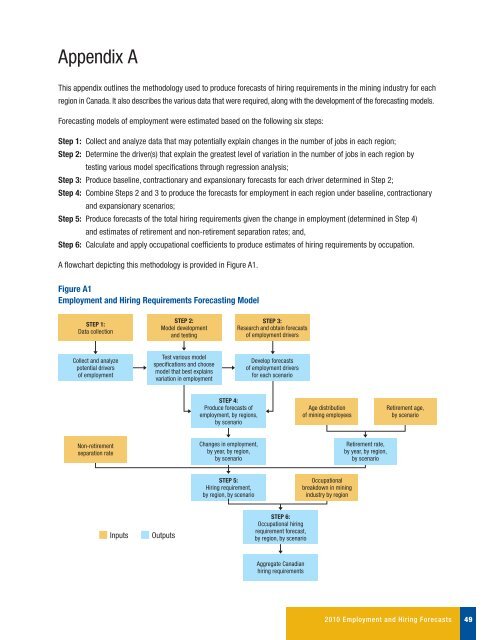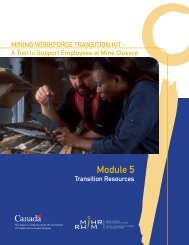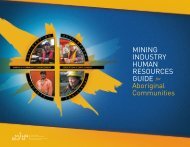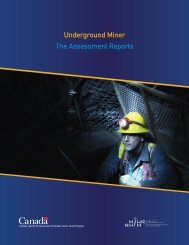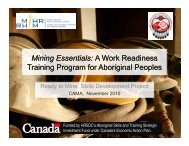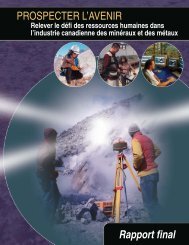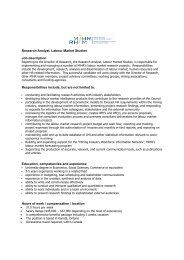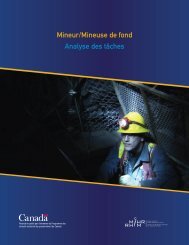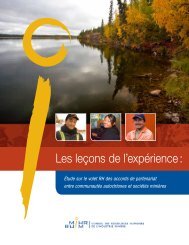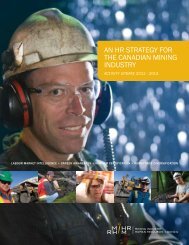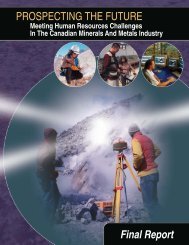Canadian Mining Industry Employment and Hiring Forecasts - MiHR
Canadian Mining Industry Employment and Hiring Forecasts - MiHR
Canadian Mining Industry Employment and Hiring Forecasts - MiHR
Create successful ePaper yourself
Turn your PDF publications into a flip-book with our unique Google optimized e-Paper software.
Appendix A<br />
This appendix outlines the methodology used to produce forecasts of hiring requirements in the mining industry for each<br />
region in Canada. It also describes the various data that were required, along with the development of the forecasting models.<br />
Forecasting models of employment were estimated based on the following six steps:<br />
Step 1: Collect <strong>and</strong> analyze data that may potentially explain changes in the number of jobs in each region;<br />
Step 2: Determine the driver(s) that explain the greatest level of variation in the number of jobs in each region by<br />
testing various model specifications through regression analysis;<br />
Step 3: Produce baseline, contractionary <strong>and</strong> expansionary forecasts for each driver determined in Step 2;<br />
Step 4: Combine Steps 2 <strong>and</strong> 3 to produce the forecasts for employment in each region under baseline, contractionary<br />
<strong>and</strong> expansionary scenarios;<br />
Step 5: Produce forecasts of the total hiring requirements given the change in employment (determined in Step 4)<br />
<strong>and</strong> estimates of retirement <strong>and</strong> non-retirement separation rates; <strong>and</strong>,<br />
Step 6: Calculate <strong>and</strong> apply occupational coefficients to produce estimates of hiring requirements by occupation.<br />
A flowchart depicting this methodology is provided in Figure A1.<br />
Figure A1<br />
<strong>Employment</strong> <strong>and</strong> <strong>Hiring</strong> Requirements Forecasting Model<br />
STEP 1:<br />
Data collection<br />
STEP 2:<br />
Model development<br />
<strong>and</strong> testing<br />
STEP 3:<br />
Research <strong>and</strong> obtain forecasts<br />
of employment drivers<br />
Collect <strong>and</strong> analyze<br />
potential drivers<br />
of employment<br />
Test various model<br />
specifications <strong>and</strong> choose<br />
model that best explains<br />
variation in employment<br />
Develop forecasts<br />
of employment drivers<br />
for each scenario<br />
STEP 4:<br />
Produce forecasts of<br />
employment, by regions,<br />
by scenario<br />
Age distribution<br />
of mining employees<br />
Retirement age,<br />
by scenario<br />
Non-retirement<br />
separation rate<br />
Changes in employment,<br />
by year, by region,<br />
by scenario<br />
Retirement rate,<br />
by year, by region,<br />
by scenario<br />
STEP 5:<br />
<strong>Hiring</strong> requirement,<br />
by region, by scenario<br />
Occupational<br />
breakdown in mining<br />
industry by region<br />
Inputs<br />
Outputs<br />
STEP 6:<br />
Occupational hiring<br />
requirement forecast,<br />
by region, by scenario<br />
Aggregate <strong>Canadian</strong><br />
hiring requirements<br />
2010 <strong>Employment</strong> <strong>and</strong> <strong>Hiring</strong> <strong>Forecasts</strong><br />
49


